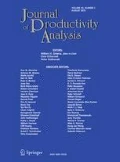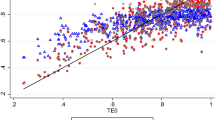Abstract
In the estimation of multiple output technologies in a primal approach, the main question is how to handle the multiple outputs. Often, an output distance function is used, where the classical approach is to exploit its homogeneity property by selecting one output quantity as the dependent variable, dividing all other output quantities by the selected output quantity, and using these ratios as regressors (OD). Another approach is the stochastic ray production frontier (SR), which transforms the output quantities into their Euclidean distance as the dependent variable and their polar coordinates as directional components as regressors. A number of studies have compared these specifications using real world data and have found significant differences in the inefficiency estimates. However, in order to get to the bottom of these differences, we apply a Monte-Carlo simulation. We test the robustness of both specifications for the case of a Translog output distance function with respect to different common statistical problems as well as problems arising as a consequence of zero values in the output quantities. Although our results show clear reactions to some statistical misspecifications, on average none of the approaches is clearly superior. However, considerable differences are found between the estimates at single replications. Taking average efficiencies from both approaches gives clearly better efficiency estimates than taking just the OD or the SR. In the case of zero values in the output quantities, the SR clearly outperforms the OD with observations with zero output quantities omitted and the OD with zero values replaced by a small positive number.


Similar content being viewed by others
Notes
In earlier versions of the analysis we also tested other scenarios, i.e. omitted variables, multicollinearity, different distributions of the inefficiency term, different variances of the noise term, and using a CES–CET multiple-output production function as a data generating process instead of a standard Translog output distance function or a Translog ray production function. Both specifications performed equally well in all these scenarios.
We calculate the efficiency estimates as \(E[ exp( -u ) ]\) (Jondrow et al. 1982; Battese and Coelli 1988). In cross-sectional settings—as in our simulation study—stochastic frontier approaches cannot produce consistent efficiency estimates (see e.g.Ondrich and Ruggiero 2001). Therefore, it could be argued that we could estimate the models by corrected OLS (COLS) rather than by maximum likelihood (SFA). In cross-sectional settings, the performance of both COLS and SFA deteriorates with decreasing inefficiency-to-noise ratio \(\lambda = \sigma _u / \sigma _v\). However, the simulation study of Jensen (2005, p. 230/231) showed that the relative performance is a bit more complicated. Regarding absolute differences to the ‘true’ inefficiencies of the DGP, SFA outperforms COLS uniformly in the face of \(\lambda \le 1\), because COLS treats the—then relatively large—amount of noise as inefficiency. With larger \(\lambda\), SFA needs larger sample sizes \(n\) to win this competition against the very simple COLS approach, e.g. \(\lambda = 8\) requires \(n \ge 500\). Regarding inefficiency ranks (correlations with or absolute differences to the true ranks in the DGP), the performances of SFA and COLS are mostly rather similar. This difference in results between inefficiency levels and inefficiency ranks is due to the advantage of the SFA in estimating the constant (or its attempt to decompose the composed error into noise and inefficiency). As SFA panel data models can provide consistent efficiency estimates, we considered extending our simulation study to panel data, but we abstained from this extension, because many different panel data specifications for SFA models exist (see e.g. Kumbhakar et al. 2014) so we would either have had to arbitrarily choose a specific panel data specification or our simulation study would have extended to an analysis of the many different panel data specifications for SFA models, which is clearly beyond the scope of our current study.
We also calculated the mean absolute deviation (MD) between the estimated and the true efficiencies (as, e.g., done by Andor and Hesse 2014): \({\text {nObs}}^{-1} \sum _i | {\hat{e}}_i - e_i |\), where nObs is the number of observations. However, we do not present the calculated MDs, because the relative performance of the estimators according to the MDs was very similar to the relative performance of the estimators according to the MADs.
For instance, in each replication, choosing the specification that gives the larger log-likelihood value or the lower \(\chi ^2\) value of Ramsey’s (1969) RESET does not result in performance measures that are significantly better than always taking the OD specification or always taking the SR specification.
The average bias of the average efficiencies from both approaches, i.e. \({\text {nObs}}^{-1} \sum _i ( ( {\hat{e}}_i^{OD} + \hat{e}_i^{SR} ) / 2 - e_i )\), is equal to the mean of the two average biases of the two approaches, i.e. \(( {\text {nObs}}^{-1} \sum _i ( {\hat{e}}_i^{OD} - e_i ) + \text {nObs}^{-1} \sum _i ( {\hat{e}}_i^{SR} - e_i ) ) / 2\), and thus, cannot simultaneously outperform both approaches.
References
Andor M, Hesse F (2014) The StoNED age: the departure into a new era of efficiency analysis? A monte carlo comparison of StoNED and the ”oldies” (SFA and DEA). J Prod Anal 41(1):85–109
Battese GE, Coelli TJ (1988) Prediction of the firm-level technical efficencies with a generalised frontier production function and panel data. J Econom 38:387–399
Coelli T, Henningsen A (2013) Frontier: stochastic frontier analysis. R package version 1.1. http://CRAN.R-project.org/package=frontier
Coelli T, Perelman S (1996) Efficiency measurement, multiple-output technologiess and distance functions: with application to European railways. CREPP Discussion Paper 96/05, Center of Research in Public Economics and Population Economics, University of Liege, Belgium
Coelli T, Perelman S (2000) Technical efficiency of European railways: a distance function approach. Appl Econ 32(15):1967–1976
Färe R, Martins-Filho C, Vardanyan M (2010) On functional form representation of multi-output production technologies. J Prod Anal 33(2):81–96
Fousekis P (2002) Distance vs. ray functions: an application to the inshore fishery of greece. Mar Resour Econ 17(4):251–267
Fuentes HJ, Grifell-Tatj’e E, Perelman S (2001) A parametric distance function approach for malmquist productivity index estimation. J Prod Anal 15:79–94
Gong BH, Sickles RC (1992) Finite sample evidence on the performance of stochastic frontiers and data envelopment analysis using panel data. J Econom 51:259–284
Jensen U (2005) Misspecification preferred: the sensitivity of inefficiency rankings. J Prod Anal 23:223–244
Jondrow J, Lovell CAK, Materov IS, Schmidt P (1982) On the estimation of technical inefficiency in the stochastic frontier production function model. J Econom 19(2–3):233–238
Kumbhakar SC (2011) Estimation of multiple output production functions. Tech. rep, Department of Economics
Kumbhakar SC, Lovell CAK (2000) Stochastic frontier analysis. Cambridge University Press, Cambridge
Kumbhakar SC, Lien G, Hardaker JB (2014) Technical efficiency in competing panel data models: a study of Norwegian grain farming. J Prod Anal 41(2):321–337
Löthgren M (1997) Generalized stochastic frontier production models. Econ Lett 57:255–259
Löthgren M (2000) Specification and estimation of stochastic multiple-output production and technical inefficiency. Appl Econ 32:1533–1540
N’Guessan YG, Featherstone A, Cader HA (2006) Choice of the empirical definition of zero in the translog multiproduct cost functional form. Selected paper prepared for presentation at the Southern Agricultural Economics Association (SAEA) Annual Meetings, Orlando, Florida
Ondrich J, Ruggiero J (2001) Efficiency measurement in the stochastic frontier model. Eur J Oper Res 129(2):434–442
Perelman S, Santin D (2009) How to generate regulary behaved production data? A Monte-Carlo experimentation on dea scale effciciency measurement. Eur J Oper Res 199:303–310
R Core Team (2014) R: a language and environment for statistical computing. R Foundation for Statistical Computing, Vienna, Austria. http://www.R-project.org/
Ramsey JB (1969) Tests for specification errors in classical linear least-squares regression analysis. J R Stat Soc Ser B (Methodol) 31(2):350–371
Roibás D, Arias C (2004) Endogeneity problems in the estimation of multi-output technologies. Tech. Rep. Efficiency Series Paper 06/2004, University of Oviedo
Ruggiero J (1999) Efficiency estimation and error decomposition in the stochastic frontier model: a Monte Carlo analysis. Eur J Oper Res 115:555–563
Whiteman JL (1999) The measurement of efficiency where there are multiple outputs. General Paper G-134, Center of Policy Studies, Monash University. http://www.monash.edu.au/policy/ftp/workpapr/g-134.pdf
Zhang T, Garvey E (2008) A comparative analysis of multi-output frontier models. J Zhejiang Univ Sci A 9(10):1426–1436
Acknowledgments
The authors are grateful to the participants of the Asia-Pacific Productivity Conference in Bangkok 2012 and two anonymous referees for their valuable suggestions for improving the paper. Of course, all errors are the sole responsibility of the authors.
Author information
Authors and Affiliations
Corresponding author
Rights and permissions
About this article
Cite this article
Henningsen, G., Henningsen, A. & Jensen, U. A Monte Carlo study on multiple output stochastic frontiers: a comparison of two approaches. J Prod Anal 44, 309–320 (2015). https://doi.org/10.1007/s11123-014-0416-9
Published:
Issue Date:
DOI: https://doi.org/10.1007/s11123-014-0416-9




